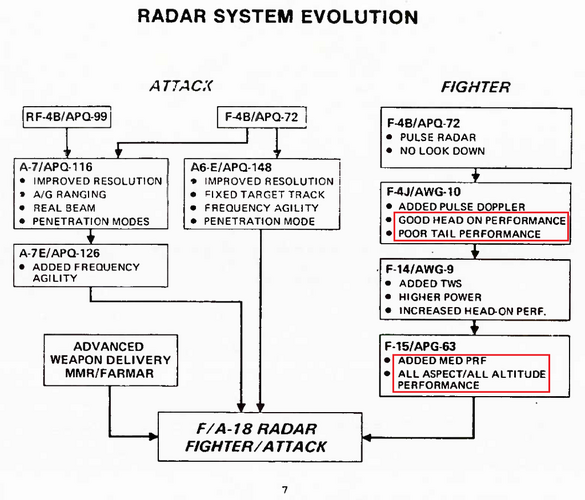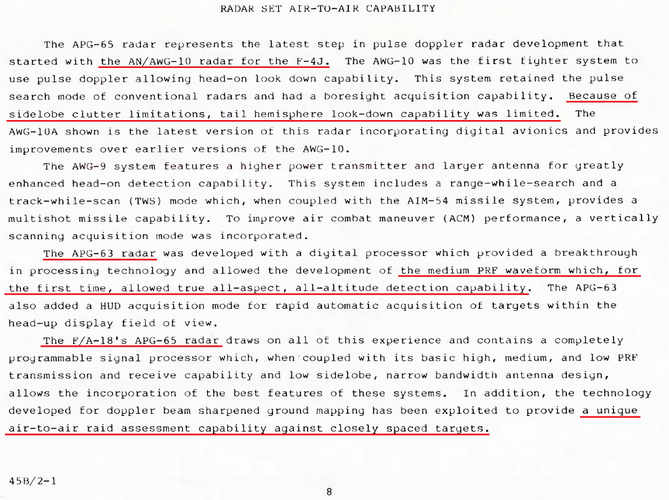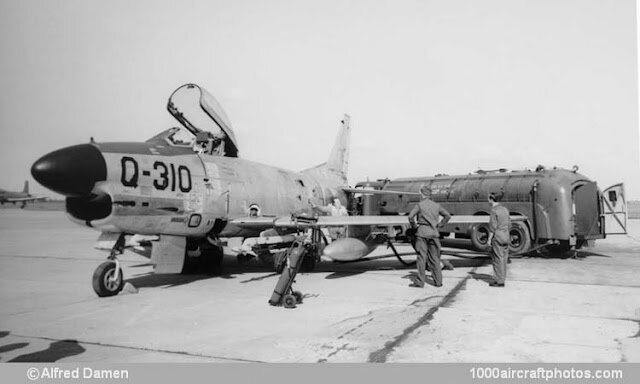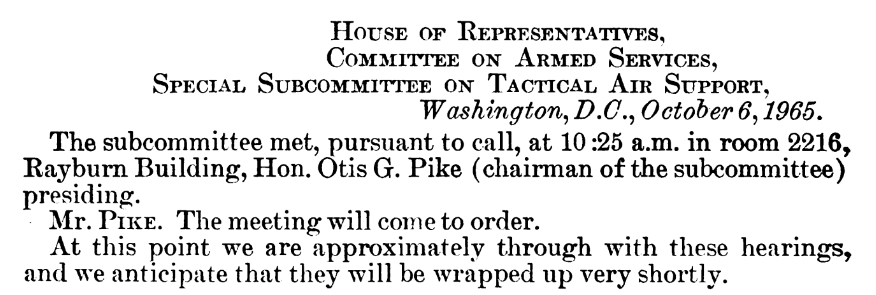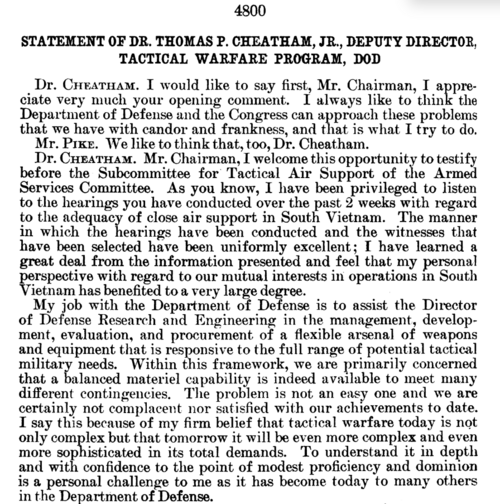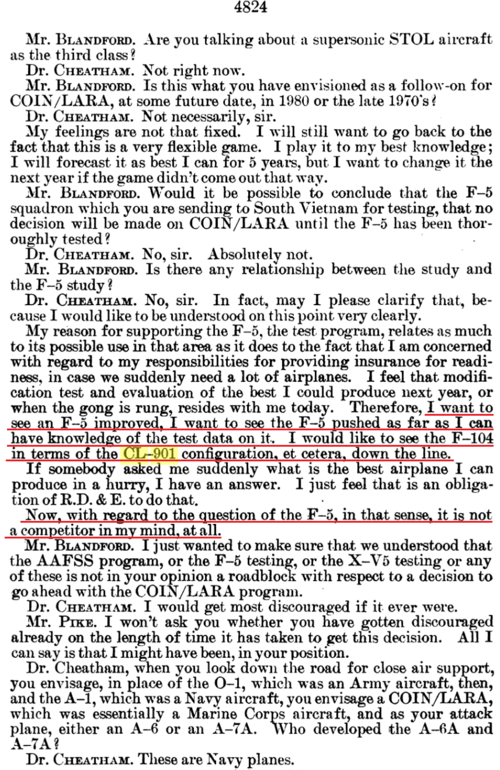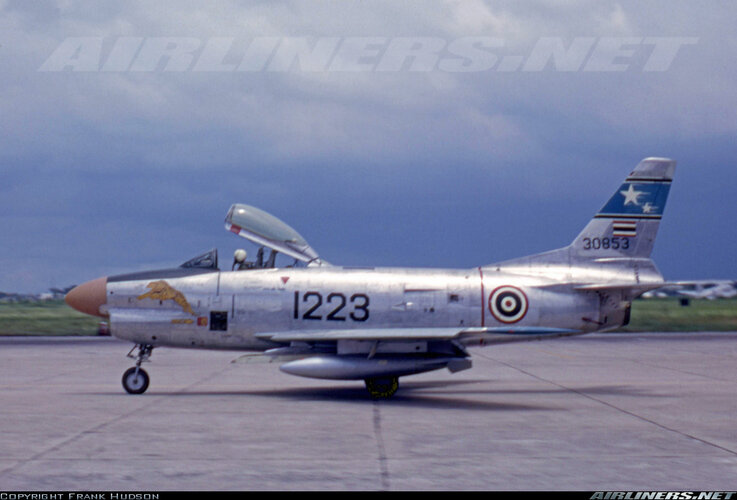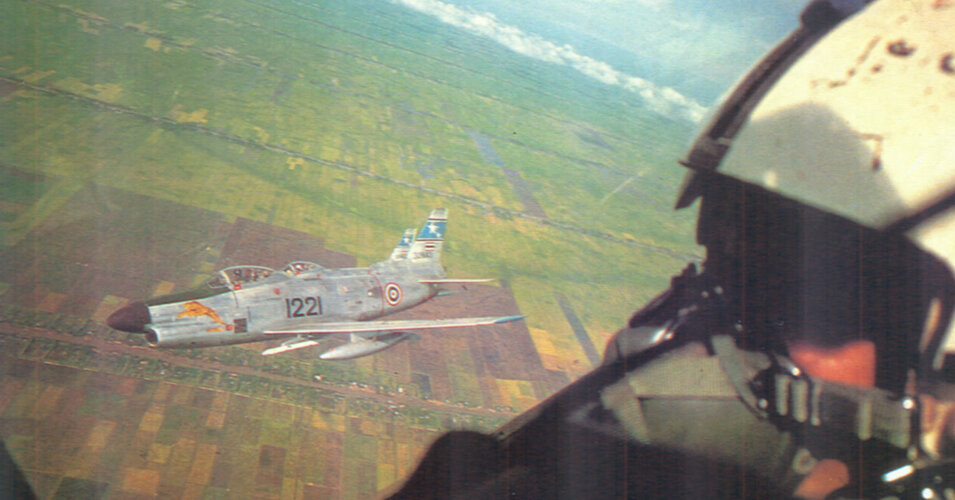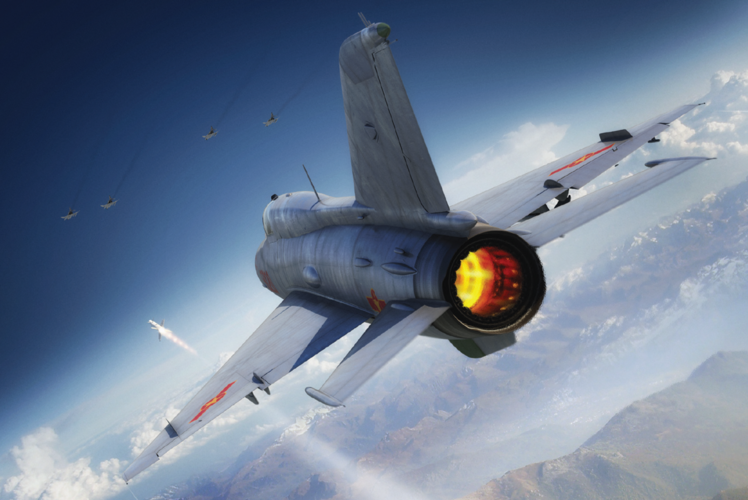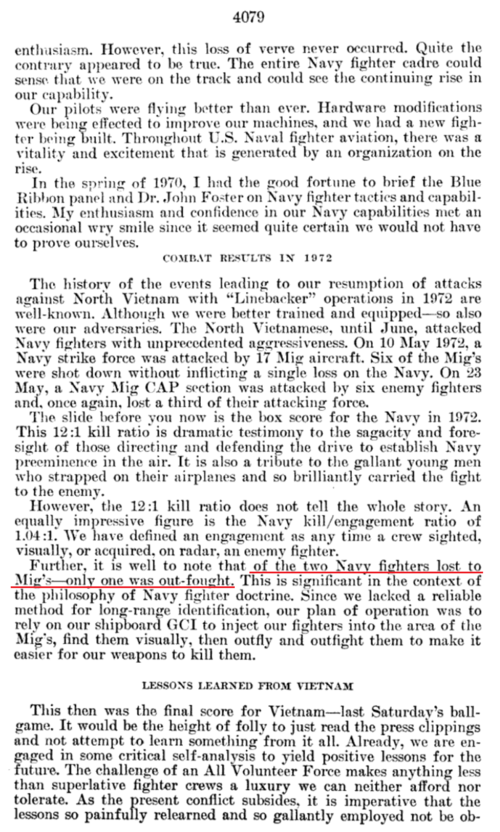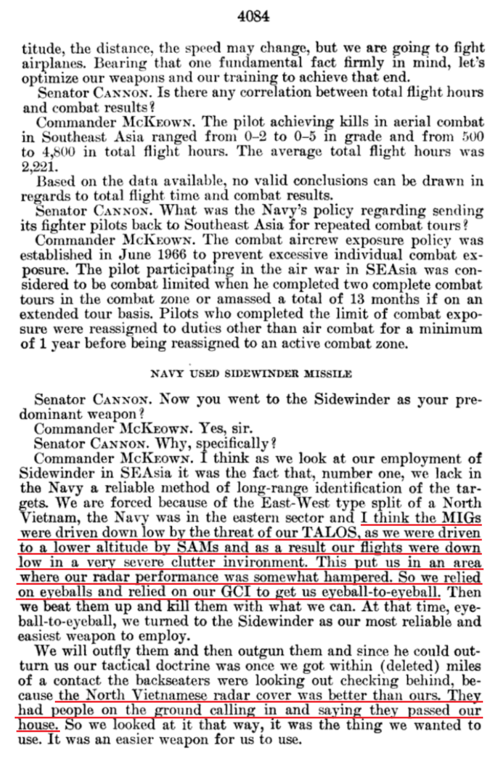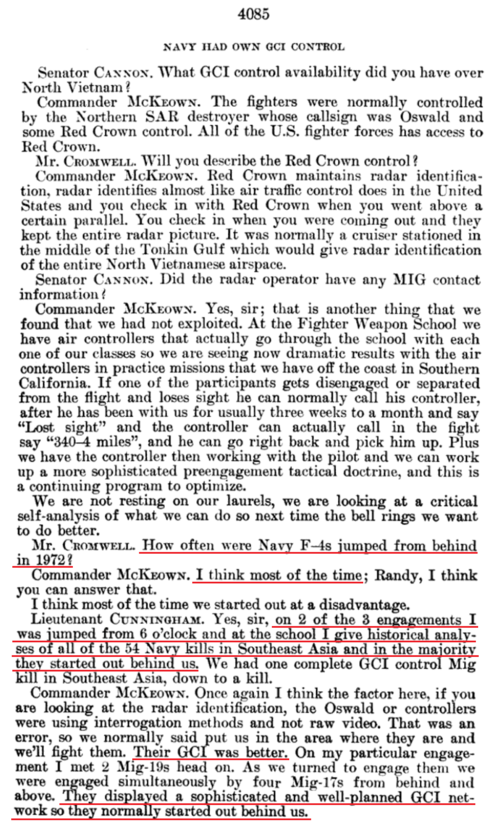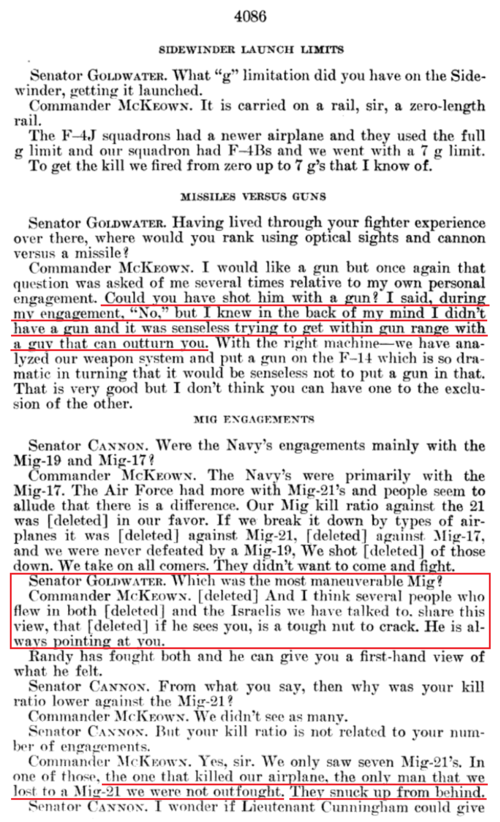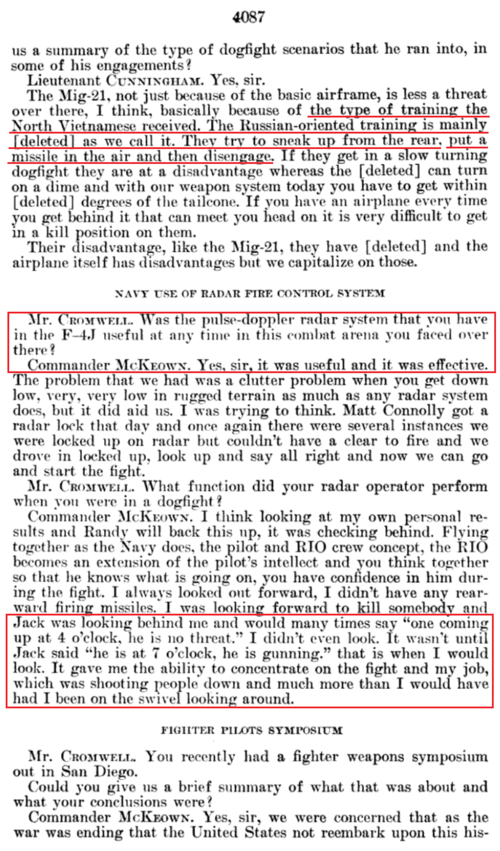You are using an out of date browser. It may not display this or other websites correctly.
You should upgrade or use an alternative browser.
You should upgrade or use an alternative browser.
Ideal USAF air superiority fighter for the Vietnam War.
- Thread starter njiiaf
- Start date
Scott Kenny
ACCESS: USAP
- Joined
- 15 May 2023
- Messages
- 11,078
- Reaction score
- 13,327
First flight in 1966, so not completely hopeless."Look down / shoot down" through pulse-doppler came with the AWG-10 and F-4J.
But it still sounds like TEABALL or AWACS is what was needed as support. More EC-121s!
- Joined
- 21 May 2006
- Messages
- 2,978
- Reaction score
- 2,225
Saying that kpuscas, the F-100's offensive punch was still somewhat limited in terms of bomb/rocket/missile load in my opinion- especially when one considers, by all accounts (using pictures from Vietnam War), that two of it's hardpoints were almost always required for drop tanks and bombs and rockets were seemingly of single pylon arrangement vs multiple pylons used by other USAF aircraft.You could argue the last "tactical" focused aircraft the USAF bought was the F-100.
Granted, the F-100's four 20mm cannons were well utilised in ground attack/CAS role.
Regards
Pioneer
Yes, that would be very nice. And if the wingtip pylons could also take the weight of a Y rack and 2x Sidewinders, that'd give you 8x total, plus all 3 drop tanks. Or 10-12x if you put the Y ranks on all 4 underwing pylons, drop tank on centerline. 10x Sidewinders if you have single mounts on the wingtips, 12x if you can get Y racks to work there.
If they don't have an AWACS to help guide them in, they're going to need better than a gun-ranging radar.
From the Air Force Magazine August 1966.
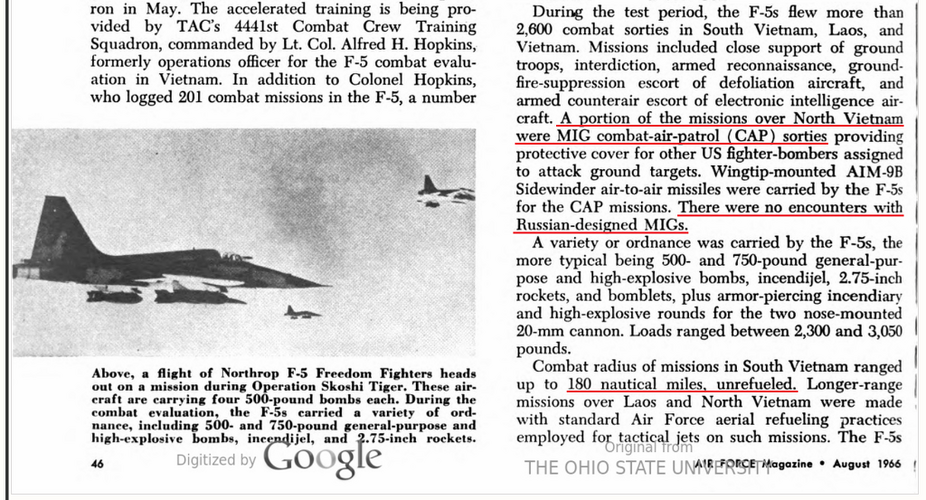
From a House hearing in June 1971.
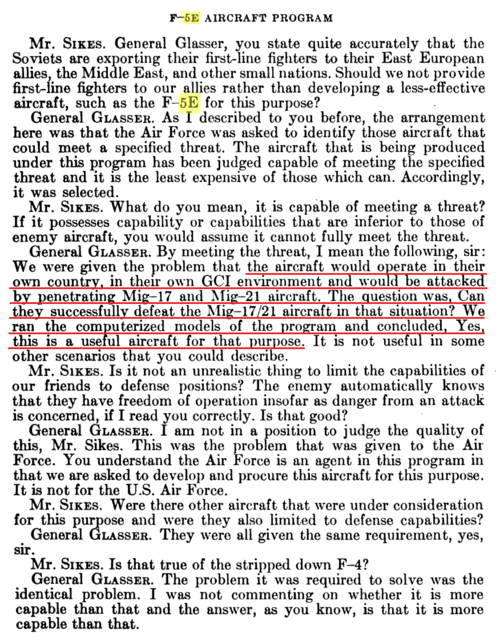
The MiG-"23" here is the Foxbat, not the Flogger.
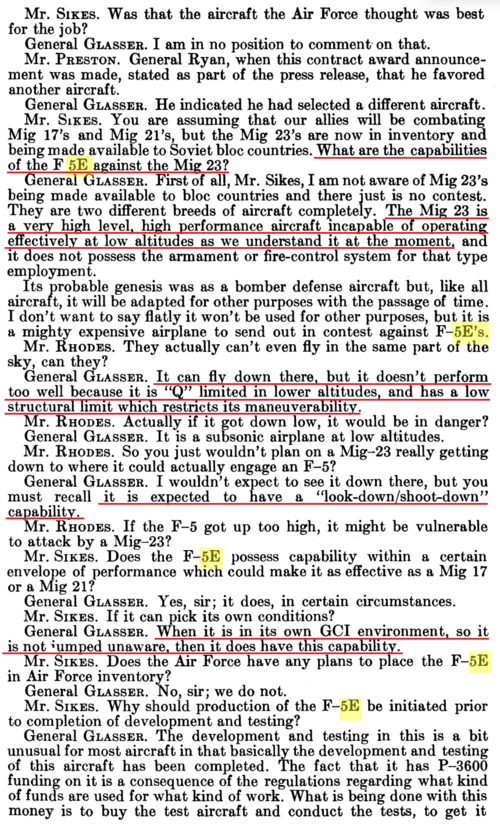
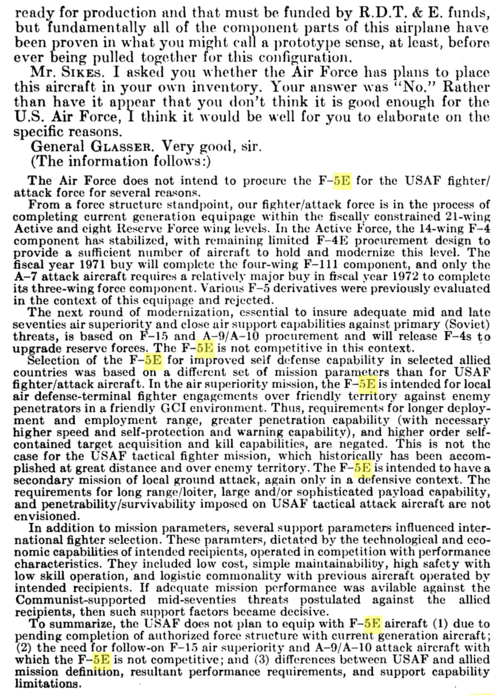
Last edited:
Scott Kenny
ACCESS: USAP
- Joined
- 15 May 2023
- Messages
- 11,078
- Reaction score
- 13,327
That pretty heavily backs up what I said.
And that gets into it. The USAF did take lightly armed F5As up over north Vietnam (dragging them via inflight refueling) but didn't have any encounters with MiGs.
F.L.
ACCESS: Top Secret
Scott Kenny
ACCESS: USAP
- Joined
- 15 May 2023
- Messages
- 11,078
- Reaction score
- 13,327
Probably equal to a MiG17 as-is, adding modern radar guns and sidewinders would be a lot of money.And the F-86 ? Could it have been an effective fighter against the MiG-17s ?
ANG F-86H.
Or perhaps a version of the F-86K with modern radar, cannons and advanced sidewinders.
View attachment 726424
Rule of cool
ACCESS: Top Secret
- Joined
- 16 January 2024
- Messages
- 1,821
- Reaction score
- 2,443
The RAAF had a small sqn of Avon Sabres based at Ubon in Thailand 1962-68, armed with 30mm cannon and Aim9b. They indirectly supported the US effort by defending Ubon, but restrictive RoE saw them sidelined and their sorties bumped for USAF Rolling Thunder sorties. I'm sure if the situation arose they'd give a good account of themselves, but to think they'd be as good as new and more capable planes is wishful thinking.
In addition to the Sabres in Thailand the RAAF deployed a small sqn of Canberras in Sth Vietnam from 1967. One was shot down by a North Vietnam SAM.
Mirage IIIO were deployed to Butterworth Malaysia in 1968.
Its not beyond the realms of possibility that RAAF Sabres or Mirages might see combat against NthV fighters with some different government or RAAF decisions.
In addition to the Sabres in Thailand the RAAF deployed a small sqn of Canberras in Sth Vietnam from 1967. One was shot down by a North Vietnam SAM.
Mirage IIIO were deployed to Butterworth Malaysia in 1968.
Its not beyond the realms of possibility that RAAF Sabres or Mirages might see combat against NthV fighters with some different government or RAAF decisions.
BlackBat242
OK, I changed my personal text ;)
- Joined
- 10 April 2013
- Messages
- 1,423
- Reaction score
- 4,051
FJ-4s should do nicely.
Their J65-W-16A engines were more powerful than most J47s (their 7,700 lb thrust matched the afterburning J47s of the F-86D/Ks), and they were designed for higher-altitude fighting than the F-86s were... they could engage in combat up to 49,000 feet - higher than even the F-86Fs could.
Their level-flight max speed was .95 Mach, and they went trans-sonic in a slight dive easily and just past Mach 1 in a moderate dive.
They carried more internal fuel than any other F-86/FJ model did (50% more than the FJ-3 or F-86E), and carried 4 AIM-9s rather than the 2 of the F-86s. They also had a decent radar-ranging gunsight - all they would need is someone to tell them where to look.
It shouldn't be too hard to fit the 8,400 lb J65-W-20 (used in the A-4Cs and retrofitted to A-4Bs) or upgrade their -16As to -20 standard if necessary - this would really boost climb and help sustain maneuver energy.
150 had been made for the USMC, all of which were retired by 1965 (even those in reserve squadrons), so they would be available.
Their J65-W-16A engines were more powerful than most J47s (their 7,700 lb thrust matched the afterburning J47s of the F-86D/Ks), and they were designed for higher-altitude fighting than the F-86s were... they could engage in combat up to 49,000 feet - higher than even the F-86Fs could.
Their level-flight max speed was .95 Mach, and they went trans-sonic in a slight dive easily and just past Mach 1 in a moderate dive.
They carried more internal fuel than any other F-86/FJ model did (50% more than the FJ-3 or F-86E), and carried 4 AIM-9s rather than the 2 of the F-86s. They also had a decent radar-ranging gunsight - all they would need is someone to tell them where to look.
It shouldn't be too hard to fit the 8,400 lb J65-W-20 (used in the A-4Cs and retrofitted to A-4Bs) or upgrade their -16As to -20 standard if necessary - this would really boost climb and help sustain maneuver energy.
150 had been made for the USMC, all of which were retired by 1965 (even those in reserve squadrons), so they would be available.
F.L.
ACCESS: Top Secret
I thought they remained in service with the Naval Reserve until the late 60s.
FJ-4s should do nicely.
Their J65-W-16A engines were more powerful than most J47s (their 7,700 lb thrust matched the afterburning J47s of the F-86D/Ks), and they were designed for higher-altitude fighting than the F-86s were... they could engage in combat up to 49,000 feet - higher than even the F-86Fs could.
Their level-flight max speed was .95 Mach, and they went trans-sonic in a slight dive easily and just past Mach 1 in a moderate dive.
They carried more internal fuel than any other F-86/FJ model did (50% more than the FJ-3 or F-86E), and carried 4 AIM-9s rather than the 2 of the F-86s. They also had a decent radar-ranging gunsight - all they would need is someone to tell them where to look.
It shouldn't be too hard to fit the 8,400 lb J65-W-20 (used in the A-4Cs and retrofitted to A-4Bs) or upgrade their -16As to -20 standard if necessary - this would really boost climb and help sustain maneuver energy.
150 had been made for the USMC, all of which were retired by 1965 (even those in reserve squadrons), so they would be available.
There was a FJ-4 with a rocket in the tail that hit Mach 1.4 (ok, not exactly useful for Vietnam).
BlackBat242
OK, I changed my personal text ;)
- Joined
- 10 April 2013
- Messages
- 1,423
- Reaction score
- 4,051
Those were the 222 FJ-4B ground attack/tactical nuclear weapon delivery versions... the 150 FJ-4s were straight fighters only issued to 3 USMC squadrons and one USN training squadron.I thought they remained in service with the Naval Reserve until the late 60s.
The FJ-4s were sent to the reserve squadrons first, then replaced by the FJ-4Bs starting around 1962.
All Furies of any type were retired from the reserves in the "mid-1960s" (or late 1960s as you note). They were replaced by A-4B/Cs as those aircraft were replaced by A-4Es and A-7As.
Also a possibility are the 156 F11F-1 "long nose" Tigers* (retired from fleet service April 1961, and only used by two training squadrons and the Blue Angels afterwards). The planned longer nose was for an AN/APS-50 radar that was never fitted - adding a small air-air radar such as the AN/APS-67 from the F-8B/Cs (or even the AN/APQ-84 of the F-8D, as it used the same radome size, and "an air-air radar from a F-8" was fitted into a modified F11F Tiger nose and fitted to an A-4B in 1965).
* 40 "short-nose" F11F-1s were also built, and they could perhaps be given new-built long noses and the other such upgrades.
Read somewhere that the M53 performs better than the F100 (at least the early ones) at high altitude/speed for this reason. Same with the TF30/F110 in the Tomcat.** All turbine engines lose some thrust at high altitudes, but turbojets lose a smaller percentage than do turbofans. This places a turbofan at a disadvantage when trying to reach high speed at high altitude when compared to a turbojet of equal sea-level thrust output. The Spey produced more sea-level thrust than the J79 - but as the aircraft neared its combat ceiling its thrust actually dropped below that of the J79.
Scott Kenny
ACCESS: USAP
- Joined
- 15 May 2023
- Messages
- 11,078
- Reaction score
- 13,327
Oh? That would be just about ideal for the lower end (MiG15/17/19) but would definitely struggle versus the MiG21s.The RAAF had a small sqn of Avon Sabres based at Ubon in Thailand 1962-68, armed with 30mm cannon and Aim9b. They indirectly supported the US effort by defending Ubon, but restrictive RoE saw them sidelined and their sorties bumped for USAF Rolling Thunder sorties. I'm sure if the situation arose they'd give a good account of themselves, but to think they'd be as good as new and more capable planes is wishful thinking.
Avon Sabres were the best of the type.
BlackBat242
OK, I changed my personal text ;)
- Joined
- 10 April 2013
- Messages
- 1,423
- Reaction score
- 4,051
Indeed the Commonwealth Aircraft Corporation-built aircraft were the best of the non-naval Sabre type - their Avon RA.7 engines put out 7,500 lb of thrust, so they also had trans-sonic capability. Their two 30mm Aden cannon were good (if a bit limited by 162 rounds per gun), but they were only fitted for 2 AIM-9 missiles - an improvement to 4 would have been necessary.Oh? That would be just about ideal for the lower end (MiG15/17/19) but would definitely struggle versus the MiG21s.
Avon Sabres were the best of the type.
The Canadair Sabre Mk 6 was almost as good as the Australian Sabre... the Orenda 14 engine put out 7,275 lb thrust (and bumped the service ceiling from the 48,000 feet of the F-86F to 55,000 feet) - but the retention of the 6x.50MG and lack of AIM-9 capability were a negative.
They were, however, available (having just been replaced by F-104s) and wiring them for AIM-9s would not be a problem.
- Joined
- 21 May 2006
- Messages
- 2,978
- Reaction score
- 2,225
Sorry Archibald, but I would think the J79 would be too big and heavy for the F-5/F-20 design in general.....Which might bring us back to a N-102 Fang derivative, incorporating the learnt and built lessons of the F-5.....?How about a "proto F-20" that is a F-5E with a J79 ?
Regards
Pioneer
I would take an F-4 over two F-5 over Vietnam every time. The F-4 is truly useful for multirole but the F-5 barely covers a few minor niches. People forget in those days there was no such thing as a multipurpose aircraft.
A single Adour might have fit in the F-5, but for what purpose? J85 fit the goals. For the cost of one Adour you could have added a third J85. While two J85 didn't get you anywhere near Mach 2, neither would an Adour.
A single Adour might have fit in the F-5, but for what purpose? J85 fit the goals. For the cost of one Adour you could have added a third J85. While two J85 didn't get you anywhere near Mach 2, neither would an Adour.
The RAAF had a small sqn of Avon Sabres based at Ubon in Thailand 1962-68, armed with 30mm cannon and Aim9b. They indirectly supported the US effort by defending Ubon, but restrictive RoE saw them sidelined and their sorties bumped for USAF Rolling Thunder sorties. I'm sure if the situation arose they'd give a good account of themselves, but to think they'd be as good as new and more capable planes is wishful thinking.
In addition to the Sabres in Thailand the RAAF deployed a small sqn of Canberras in Sth Vietnam from 1967. One was shot down by a North Vietnam SAM.
Mirage IIIO were deployed to Butterworth Malaysia in 1968.
Its not beyond the realms of possibility that RAAF Sabres or Mirages might see combat against NthV fighters with some different government or RAAF decisions.
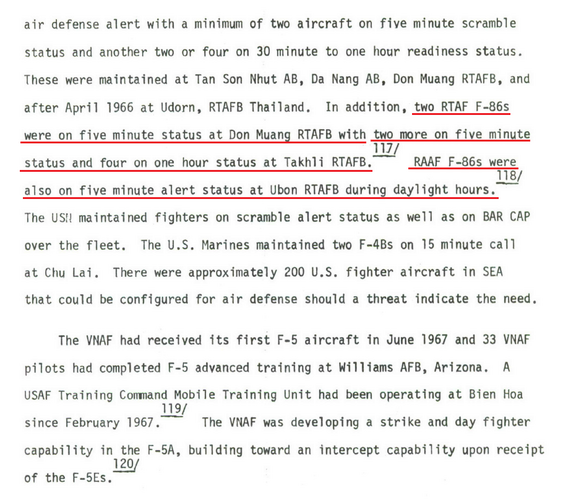
F.L.
ACCESS: Top Secret
Scott Kenny
ACCESS: USAP
- Joined
- 15 May 2023
- Messages
- 11,078
- Reaction score
- 13,327
IIRC the Sabers had 2x pylons per wing, so wiring and adding the Argon bottles should be relatively simple.Indeed the Commonwealth Aircraft Corporation-built aircraft were the best of the non-naval Sabre type - their Avon RA.7 engines put out 7,500 lb of thrust, so they also had trans-sonic capability. Their two 30mm Aden cannon were good (if a bit limited by 162 rounds per gun), but they were only fitted for 2 AIM-9 missiles - an improvement to 4 would have been necessary.
As to the guns, if the pilot can get a hit with a burst of 10-20 rounds per gun, a single 30mm will do ugly things to a plane.
The .50cals would be basically useless. It takes way too much .50cal fire into an airplane to break something flight-critical.The Canadair Sabre Mk 6 was almost as good as the Australian Sabre... the Orenda 14 engine put out 7,275 lb thrust (and bumped the service ceiling from the 48,000 feet of the F-86F to 55,000 feet) - but the retention of the 6x.50MG and lack of AIM-9 capability were a negative.
They were, however, available (having just been replaced by F-104s) and wiring them for AIM-9s would not be a problem.
I would take an F-4 over two F-5 over Vietnam every time. The F-4 is truly useful for multirole but the F-5 barely covers a few minor niches. People forget in those days there was no such thing as a multipurpose aircraft.
My take is that a gun-toting F-4 fits the bill stipulated in this thread far better than any of the US aircraft they were making or designing in the 1960s. And it is easy & fast to do, too.
Rule of cool
ACCESS: Top Secret
- Joined
- 16 January 2024
- Messages
- 1,821
- Reaction score
- 2,443
IIRC the Sabers had 2x pylons per wing, so wiring and adding the Argon bottles should be relatively simple.
As to the guns, if the pilot can get a hit with a burst of 10-20 rounds per gun, a single 30mm will do ugly things to a plane.
The .50cals would be basically useless. It takes way too much .50cal fire into an airplane to break something flight-critical.
Without the tanks it probably lacked the range required, the RAAF Mirages usually carried 500l supersonic tanks for the same reason.
BlackBat242
OK, I changed my personal text ;)
- Joined
- 10 April 2013
- Messages
- 1,423
- Reaction score
- 4,051
Which is why my preference would be the FJ-4s - that 50% greater fuel capacity has a lot going for it.
And it has the 20mm cannon and is already wired for 4 AIM-9.
And it has the 20mm cannon and is already wired for 4 AIM-9.
Sounds like you don't care about true Air Superiority. Korean War era fighters, even with a bigger engine and more fuel, have little room for improvements. The lesson over Vietnam is never get complacent. What was superior early wasn't so hot for long. The platform has to evolve. And by the way, budgets matter so you want to stick to fewer platforms for more roles. Change the equipment and aircrew but use the same plane. The F-4 was the poster child of this strategy.
1635yankee
Recovering aeronautical engineer
- Joined
- 18 August 2020
- Messages
- 535
- Reaction score
- 720
I like the Lockheed Lancer. It's what the F-104 should have beenUpon further research my proposed wing isn't even necessary.. I still like it for obviously flawed and biased reasons.. But the 98-L version of the Tiger/SuperTiger or the F-12 with 350 sqft. wing that developed out of it would be totally fine for the job! The Air Force evaluated the supeTiger and gave it excellent reviews inclusive of the test team recommending it for purchase.
You can get close to the 98-L by swapping the wing tips with slightly larger ones to bring the span to 34 feet from 31 and change.
Scott Kenny
ACCESS: USAP
- Joined
- 15 May 2023
- Messages
- 11,078
- Reaction score
- 13,327
They would be facing Korean War era fighters for the most part. MiG17s. This is basically applying Boyd's Fighter Mafia thinking at about the time he was developing the idea: Yes, you have the expensive highly capable planes (F4s for Vietnam), but those don't give you the mass numbers you need. So you pull some relatively capable aircraft out of the Boneyard, like FJ-4s.Sounds like you don't care about true Air Superiority. Korean War era fighters, even with a bigger engine and more fuel, have little room for improvements. The lesson over Vietnam is never get complacent. What was superior early wasn't so hot for long. The platform has to evolve. And by the way, budgets matter so you want to stick to fewer platforms for more roles. Change the equipment and aircrew but use the same plane. The F-4 was the poster child of this strategy.
Once MiG19s and -21s start being the major threat, then we can put more advanced aircraft in play.
Rule of cool
ACCESS: Top Secret
- Joined
- 16 January 2024
- Messages
- 1,821
- Reaction score
- 2,443
By my count the USAF tried 4 fighters in Vietnam; F100, F102, F104 and F4, they didn't use the F101, F106 or re-activate older designs even though they could have if that was the best way to go.
That suggests that of the aircraft immediately available to it the F4 was the best aircraft for the job. I think the only way to beat the F4 would be a clean sheet design.
That suggests that of the aircraft immediately available to it the F4 was the best aircraft for the job. I think the only way to beat the F4 would be a clean sheet design.
Scott Kenny
ACCESS: USAP
- Joined
- 15 May 2023
- Messages
- 11,078
- Reaction score
- 13,327
And the F-5 for a short time.By my count the USAF tried 4 fighters in Vietnam; F100, F102, F104 and F4, they didn't use the F101, F106 or re-activate older designs even though they could have if that was the best way to go.
Probably. Which would have required seeing that the USAF training was deficient in WVR encounters in about 1960, maybe 1963 at the latest if you are trying to get a plane into service in 1968.That suggests that of the aircraft immediately available to it the F4 was the best aircraft for the job. I think the only way to beat the F4 would be a clean sheet design.
The F8U was not more maneuverable. The F5D had better TW and WL, much higher climb rate, better visibility, and longer range. The only advantage the F8U has is its speed.F5D was limited by wave drag. I see no reason it was superior to F-8 in the stock engine let alone if F-8 had been equipped with J79. They both shared the same radar and F-8 just needed the director equipment for Sparrow to match F5D. The F-8 was superior in agility, mobility, and raw speed; keys for survival in that age. F5D offered nothing over that save for potential to be a larger target.
I suggested the crossbreeding to create a joint design between two companies that equipped both services. The two eventually would merge.
Baloney. The F-8 had better roll rate, instant turn rate, and sustained turn rate. And its better speed and accelleration is because of its less draggy design. And F5D had lower TWR. F-8 clearly was the superior energy fighter. F5D never ever had J79. This constant rewriting history that F5D is magical once it gets J79 is bothersome because F-8 would have just as readily had the same engine upgrade path available.The F8U was not more maneuverable. The F5D had better TW and WL, much higher climb rate, better visibility, and longer range. The only advantage the F8U has is its speed.
1635yankee
Recovering aeronautical engineer
- Joined
- 18 August 2020
- Messages
- 535
- Reaction score
- 720
...The F8U was not more maneuverable. The F5D had better TW and WL, much higher climb rate, better visibility, and longer range. The only advantage the F8U has is its speed.
and the fact that there were more than two of them.
Rule of cool
ACCESS: Top Secret
- Joined
- 16 January 2024
- Messages
- 1,821
- Reaction score
- 2,443
And the F-5 for a short time.
Probably. Which would have required seeing that the USAF training was deficient in WVR encounters in about 1960, maybe 1963 at the latest if you are trying to get a plane into service in 1968.
I forgot about the F5, so we have a real cross section of fighter types from the brand new to the relatively old and the straight line speedsters to the highly agile. Yet none of these aircraft were able to get great results in the environment of Rolling Thunder. IIUC this was indicative of the USAF culture of the time rather than the aircraft they were flying. I've read that from 1960 the USAF put a big focus in flying safety after a horrific, HORRIFIC 50s in terms of plane crashes and aircrew deaths. Apparently the crash rate reduced but at least in part due to a reduction in dangerous training like close air to air combat flying which develops skills.
Actually the Vietnamese were in defensive positions, therefore the US showing parity is actually gaining immense superiority. Defenders should win disproportionately as logistics are in their favor by a large margin.
Kat Tsun
eeeeeeeeeeeeeee
- Joined
- 16 June 2013
- Messages
- 1,355
- Reaction score
- 1,753
Actually the Vietnamese were in defensive positions, therefore the US showing parity is actually gaining immense superiority. Defenders should win disproportionately as logistics are in their favor by a large margin.
This is a really weird way to phrase "we didn't lose as hard as the numbers suggested we should've" tbf. Nobody keeps score. North Vietnam was so good at defending that it literally never had to the fight the U.S. Army's tank divisions inside its own country. Defenders who win without firing a shot against invaders' own armies are the best defenders of all at the end of the day.
Bombing the enemy is pointless if you don't invade. I'd have thought Goering taught the world this but the USAF missed that memo.
Sounds like you don't care about true Air Superiority.
What, pray tell, is the actual air threat of the VPAF? A few An-2s with hand grenades and an RPD on the back?
The Vietnam War air threat was so non-existent that "air superiority" was meaningless. The Vietnamese were running defensive, a position no air force should be in, literally the entire war. In that case, literally any aircraft can work for air superiority, probably including F-86s, if the USAF had simply trained its pilots good. It didn't. The Navy did. What was lacking was a ground invasion and the capacity to permanently occupy the North, and the U.S. did not have this ability, otherwise it would have done so.
The best air superiority fighter is either an F-104G, which was in production at the time, or the F-4B which was actually adopted.
Neither are genuinely better than the other, what the F-104G lacks in human factors and growth potentials it gains in production numbers, and what the F-4B lacks in cheapness and ready availability of parts it gains in being able to soldier on for 30+ more years in main combat roles.
Last edited:
Similar threads
-
-
-
Covert Wings: The OA-61F Counter Widow in Vietnam
- Started by kpuscas
- Replies: 9
-
US forces with a second JFK term and shorter/no Vietnam war?
- Started by Elan Vital
- Replies: 72
-
Rolling Thunder & Linebacker Cruise Missiles campaigns against North Vietnam??
- Started by Pioneer
- Replies: 55

